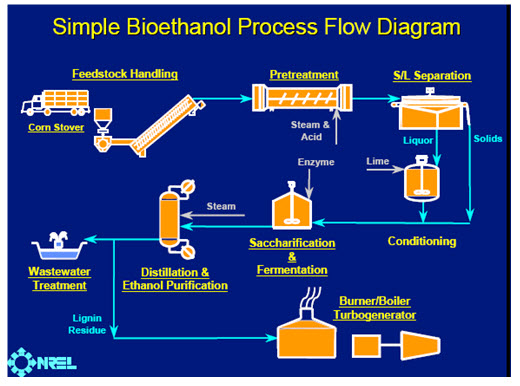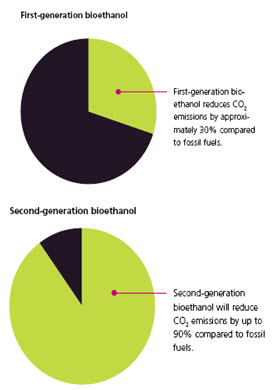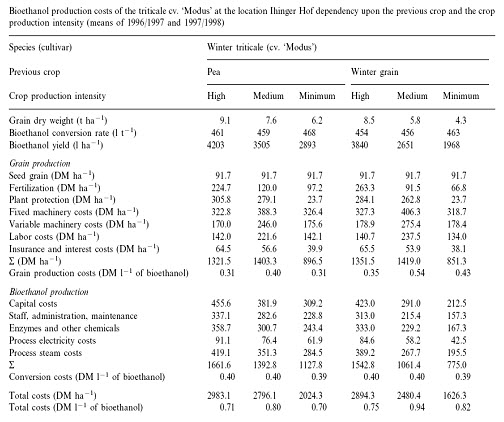Site pages
Current course
Participants
General
MODULE 1. Overview of renewable energy sources
MODULE 2. Characterization of Biomass
MODULE 3. Thermochemical conversion Technology (TCCT)
MODULE 4. Biochemical conversion Technology-Biogas...
MODULE 5. Bio-fuels (BCCT)
MODULE 6. Solar Energy Conversion System (SECS)
MODULE 7. Hydro-Energy Conversion System (HECS)
MODULE 8. Wind Energy Conversion System (WECS)
MODULE 9. Ocean Energy Conversion System (OECS)
MODULE 10. Energy conservation in agriculture
LESSON 19. Bio-Ethanol Production
Bio-ethanol is an environmentally friendly fuel for vehicles that normally run on petrol. As a renewable source of energy, it reduces demand on fossil fuels while it burns more cleanly and with reduced emissions of CO2, a greenhouse gas. As an energy source, bio-ethanol is carbon neutral in that it reduces, by up to 70 %, the amount of greenhouse gas released into the atmosphere. The CO2 released during ethanol production and combustion in an engine has already been absorbed from the atmosphere during the growth of the crops due to photosynthesis. The reduction of greenhouse gases, to meet the climate change targets set by the Kyoto Protocol, is responsible for fuelling the current boom in biofuels.
Bio-ethanol is a versatile transportation fuel and fuel additive that offers excellent performance and reduced air pollution compared to conventional fuels. Its production and use adds little, if any, net release of carbon dioxide to the atmosphere, dramatically reducing the potential for global climate changes.

Bio-ethanol is produced by the fermentation of sugar, a well established process used in the production of beer and alcohol.
Carbohydrates such as starch from cereal and tuber crops – which is enzymatically converted into simple sugars – and natural sugars from sugar beet, sugar cane and sweet sorghum crops are fermented using yeast to produce a mash containing ethanol, water and unfermented solids. Distillation columns separate ethanol from the fermented mash, with additional purification taking place in rectification columns to produce an ethanol and water mixture. Dehydration is the step of removing the last of the water, taking the mixture beyond its azeotropic equilibrium to produce anhydrous ethanol, or bio-ethanol.
A significant advantage of bio ethanol is that it can be blended with petrol as both an oxygenator and octane enhancer. Environmental concerns due to the widespread use of MTBE (methyl tertiary butyl ether, a possible carcinogen) in unleaded petrol have prompted drives to seek alternatives. Bio-ethanol provides an ideal solution in that it is a renewable and environmentally friendly petrol extender, while providing a direct substitute for MTBE as an octane enhancer. Ethanol is also suitable as a feedstock for producing other octane enhancers such as ETBE (ethyl tertiary butyl ether) or TAEE (tertiary amyl ethyl ether), considered safer than MTBE.
Additional revenue streams are available from the spent products that result from ethanol production. These are usually dried to produce DDGS (distiller’s dried grains with solubles) marketed as a protein and nutrient rich animal feed for cattle, pigs and poultry. Alternatively, the biomass can be utilised as a renewable fuel source, producing electrical power and heat for the process, or for conversion into methane for use as a fuel. These energy conversion technologies enhance the overall production energy balance and enable further carbon credits to be earned.
Advantages Of Bio-ethanol
The overwhelming advantage of bio-ethanol for the environment is its potential to be carbon neutral on a lifecycle basis – meaning the carbon dioxide (CO2) emitted during its use is offset by the absorption from the atmosphere during its growth.
With emissions of CO2 and nitrous oxide taken into account, some studies suggest that lifecycle greenhouse gas emissions can be reduced by 90% with bio-ethanol compared to petrol. This is a best-case scenario however, using sugar cane as the crop and large amounts of bagasse (the remaining wood fibres after the juice is extracted) used for heat energy. Nevertheless, even by current European standards the emission reductions are significant – around 35-65% depending on the processing method.
Bio-ethanol also has the advantage of lower taxation. The UK government has reduced fuel duty on bio-ethanol, which offsets the higher production costs. The first supermarkets in the UK selling E85 offered it at around 2p cheaper than conventional petrol but typically you would use much more bio-ethanol per mile than traditional fuel – around 50% more if you’re using 100% bio-ethanol.
DISADVANTAGES OF BIOETHANOL
There are many concerns over the use of bio-ethanol as a long-term alternative in the fuelling of cars. These include:
-
Biodiversity – A large amount of arable land is required to grow crops. This could see some natural habitats destroyed including rainforests.
-
The food V fuel debate – There is concern that due to the lucrative prices of bio-ethanol some farmers may sacrifice food crops for biofuel production which will increase food prices around the world.
-
Carbon emissions – There is debate over the neutrality of bio-ethanol when all elements are taken into consideration including the cost of changing the land use of an area, transportation and the burning of the crop.
There are also concerns over the fuel systems used. Too many older cars are currently unequipped to handle even 10% ethanol while there is concern that using 100% ethanol decreases fuel economy by around 15-30% compared with 100% petroleum.
FUEL ECONOMY- PRICES, POLICY – ENERGY CRISIS
The capital costs occurred to be always the most expensive position in conversion, followed by the expenditures for process steam input. The expenses for electricity formed the lowest proportion. Approximately 75% of the process auxiliary costs were due to the technical enzyme products.
Generally, as the crop production intensity increased, the conversion costs on a per hectare basis increased as well. The increment was proportional to the grain yield increase, since the costing are based on the specific amount of processed grain per hectare and not on the amount of bio-ethanol produced. This method allows appreciating the economic advantage of increased bio-ethanol conversion rates per equivalent tons of grain. As the calculations prove, the conversion costs on a per liter basis were relatively the same independent of the scale that results directly from the applied method of costing. However, the results revealed that the conversion costs per liter of bio ethanol produced were evidently affected by the bio ethanol conversion rates, which depended primarily on the genotype’s fermenting traits.
Bio-ethanol can reduce the environmental impact of the transport sector:
The transport sector is responsible for about one fifth of CO2 emissions on a global scale. If nothing is done, transport is expected to be the main driver of future global CO2 emission increases. Bio ethanol and bio diesel are currently the only readily available alternatives to fossil fuel.
It is now commonly accepted that first generation bio-ethanol is able to reduce CO2 emissions by between 20 and 50% compared to petroleum based fuels depending on the energy efficiency of the bio-ethanol plant. This figure is likely to increase as the technology develops. It is expected that second-generation bio-ethanol will be able to reduce CO2 emissions by as much as 90% compared to petroleum-based fuels.



Production of Bio fuel (Ethanol)
Ethanol can be commercially produced by a variety of methods. The fermentation method is the one, which make use of naturally occurring renewable raw materials. Any material, which is capable of being fermented by enzymes, can serve as a source for ethanol production.
There is an abundance of farm crops/residues which can be of being used as raw materials in the fermentation process leading to ethanol production. Starch based feed stock include a variety of cereals, grains and tubers like cassava, yam, sweet potato etc. Starchy feed stocks can be hydrolyzed to get fermentable sugar syrup and give an average yield upto 42 litres of ethanol per 100 kg of feed stock.
General production process
The starch bearing materials are steamed for one to two hours at two to three atmospheric pressures to gelatinize the starch present. The resultant pulp is cooled to about 50°C and an equal volume of water and 10 per cent malt is added. The mixture is allowed to stand for a short while, when the starch is converted to dextrin. The temperature is gradually raised to about 50°C while dextrin is converted first to maltose and then to dextrose.
Yeast is then added to the liquid mash and fermentation is allowed to proceed for a couple of days. The yeast converts sugar into ethanol. The ethanol water mixture is sent through additional distillation columns where ethanol concentration is increased to 190 proof (95 per cent ethanol). This in turn is dried through an extra active distillation process to yield 200 proof ethanol.